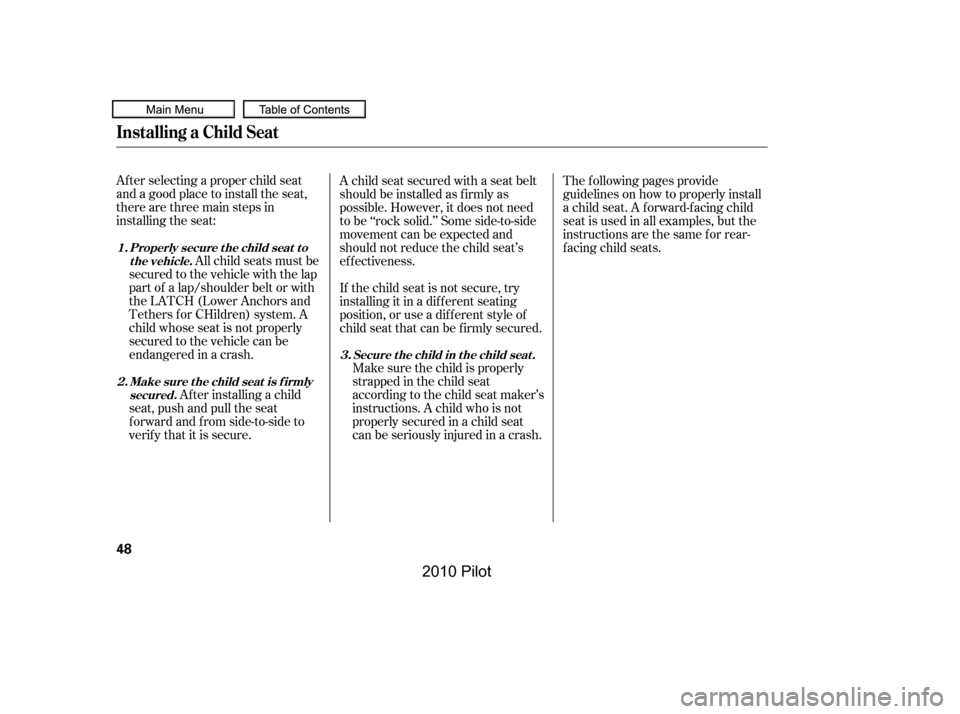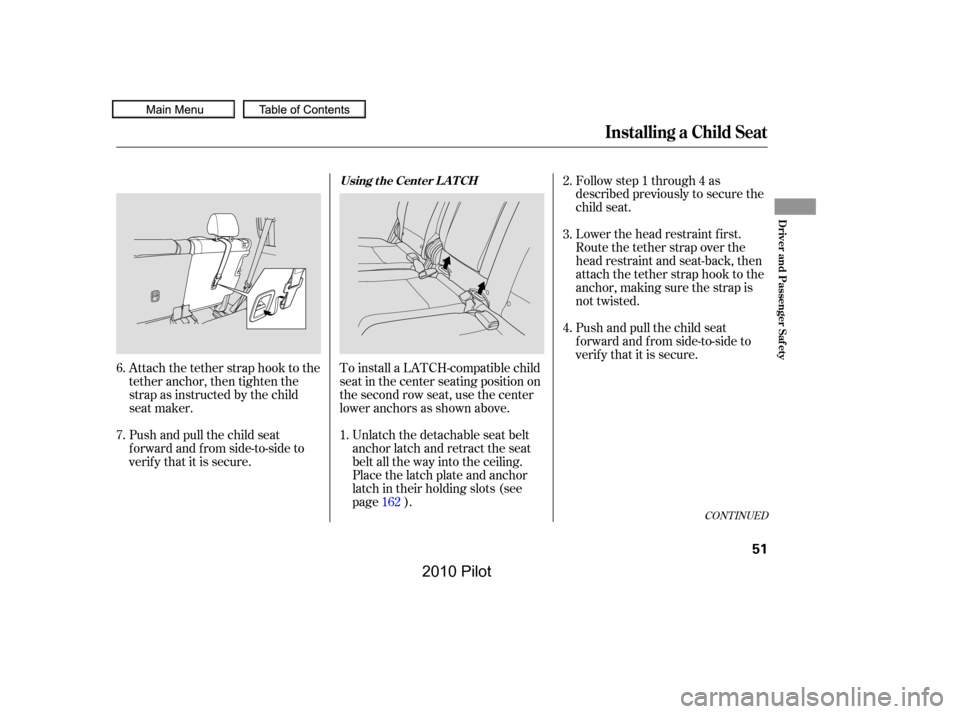Page 46 of 575

�µ
Your vehicle has two rows of back
seats where children can be properly
restrained. If you ever have to carry
a group of children, and a child must
ride in f ront:
Place the largest child in the f ront
seat, provided the child is large
enough to wear the lap/shoulder
belt properly (see page ).
Move the vehicle seat as far to the
rear as possible (see page ).
Have the child sit upright and well
backintheseat(seepage ).
Make sure the seat belt is properly
positioned and secured (see page
).
Many parents say they pref er to put
an inf ant or a small child in the f ront
passenger seat so they can watch the
child, or because the child requires
attention.
Placing a child in the f ront seat
exposes the child to hazards in a
f rontal collision, and paying close
attention to a child distracts the
driver from the important tasks of
driving, placing both of you at risk.
If a child requires close physical
attention or f requent visual contact,
we strongly recommend that another
adult ride with the child in a back
seat. The back seat is far safer for a
child than the front.
57
15
19
17
If You Must Drive with Several
Children
If a Child Requires Close
Attention
Protecting Children General Guidelines
42
�����—�����—�
���y�
���������
���y���
�(�/�����
���y���������y
2010 Pilot
Page 47 of 575

�µ
For example, infants and small
childrenleftinavehicleonahot
day can die f rom heatstroke. A
child lef t alone with the key in the
ignition switch can accidentally set
the vehicle in motion, possibly
injuring themselves or others.
If you are not wearing a
seat belt in a crash, you could be
thrown forward and crush the
child against the dashboard or a
seat-back. If you are wearing a
seat belt, the child can be torn
from your arms and be seriously
hurt or killed.
During a crash, the
belt could press deep into the child
and cause serious or fatal injuries.
If a child wraps a loose
seat belt around their neck, they
can be seriously or f atally injured.
(See pages and f or how to
activate and deactivate the
lockable retractor.)
If they do, they
could be very seriously injured in a
crash.
This can prevent
children f rom accidentally f alling
out (see page ).
Children who play in
vehicles can accidentally get
trapped inside. Teach your
children not to play in or around
vehicles.
Even very young
children learn how to unlock
vehicle doors, turn on the ignition
switch, and open the tailgate or
the glass hatch, which can lead to
accidental injury or death.
Leaving children without
adult supervision is illegal in most
states, and Canadian provinces/
territories, and can be very
hazardous.
144
5354
Protecting Children General Guidelines
Additional Saf ety Precautions
Neverholdaninfantorchildon
your lap.
Never put a seat belt over yourself
and a child.
Make sure any unused seat belt
t hat a child can reach is buckled,
the lockable retractor is activated,
and the belt is f ully retracted and
locked.
Never let two children use the
same seat belt .
Use t he childproof door locks t o
prevent children f rom opening t he
rear doors.
Lock all doors, the tailgate and the
glass hat ch when your vehicle is
not in use.
K eep vehicle keys/remot e
transmitters out of the reach of
children.
Do not leave children alone in a
vehicle.
Driver and Passenger Saf ety
43
�����—�����—�
���y�
�������������y���
�(�/�����
���y���������y
2010 Pilot
Page 51 of 575

When buying a child seat, you need
to choose either a conventional child
seat, or one designed f or use with
the Lower Anchors and Tethers f or
CHildren (LATCH) system.
Conventional child seats must be
secured to a vehicle with a seat belt,
whereas LATCH-compatible seats
are secured by attaching the seat to
hardware built into the rear seating
positions.
In seating positions and vehicles not
equipped with LATCH, a LATCH-
compatible child seat can be installed
using a seat belt.
Since LATCH-compatible child seats
are easier to install and reduce the
possibility of improper installation,
we recommend selecting this style.
Whatever type of seat you choose, to
provide proper protection, a child
seat should meet three
requirements:
Look f or FMVSS 213 or CMVSS
213 on the box.
Rear-facing for infants, forward-
f acing f or small children.
Bef ore purchasing a conventional
child seat, or using a previously
purchased one, we recommend that
you test the seat in the specif ic
vehicle seating position or positions
where the seat will be used.
Selecting a Child Seat
T he child seat should meet
Federal Mot or Vehicle Saf et y
St andard 213 or Canadian Mot or
Vehicle Saf et y St andard 213.
T he child seat should be of the
proper type and size to f it the child.
T he child seat should f it the
vehicle seat ing posit ion (or
posit ions) where it will be used.
1.
2.
3.
Driver and Passenger Saf ety
47
�����—�����—�
���y�
�������������y���
�(�/�����
���y���������y
2010 Pilot
Page 52 of 575

Af ter selecting a proper child seat
and a good place to install the seat,
there are three main steps in
installing the seat:
All child seats must be
secured to the vehicle with the lap
part of a lap/shoulder belt or with
the LATCH (Lower Anchors and
Tethers f or CHildren) system. A
child whose seat is not properly
secured to the vehicle can be
endangered in a crash.
Af ter installing a child
seat, push and pull the seat
f orward and f rom side-to-side to
verify that it is secure.
A child seat secured with a seat belt
should be installed as f irmly as
possible. However, it does not need
to be ‘‘rock solid.’’ Some side-to-side
movement can be expected and
should not reduce the child seat’s
ef f ectiveness.
If the child seat is not secure, try
installing it in a dif f erent seating
position, or use a dif f erent style of
child seat that can be f irmly secured.
Make sure the child is properly
strappedinthechildseat
according to the child seat maker’s
instructions. A child who is not
properly secured in a child seat
can be seriously injured in a crash.
The f ollowing pages provide
guidelines on how to properly install
a child seat. A f orward-f acing child
seat is used in all examples, but the
instructions are the same f or rear-
f acing child seats.Properly secure t he child seat t o
the vehicle.
Make sure t he child seat is f irmly
secured.
Secure the child in the child seat.
1.
2.
3.
Installing a Child Seat
48
�����—�����—�
���y�
�������������y���
�(�/�����
���y���������y
2010 Pilot
Page 53 of 575

CONT INUED
To install a LATCH-compatible child
seat in either outer second row seat:
Move the seat belt buckle or
tongue away f rom the lower
anchors.
Make sure there are no objects
near the anchors that could
prevent a secure connection
between the child seat and the
anchors.
Your vehicle is equipped with
LATCH (Lower Anchors and
Tethers f or CHildren) at each of the
second row seats and the passenger’s
side third row seat.
When you install a child seat in the
second row seating position, use the
loweranchorsasshowninthe
illustration. You can install up to
three child seats at a time with
LATCH.
Do not attach two child seat
connectors to a single lower anchor
at a time.
You can f ind lower anchors in the
slits in the seat-backs.
The lower anchors are located
between the seat-back and seat
bottom, and are to be used only with
a child seat designed f or use with
LATCH.
The location of each lower anchor is
indicated by a small button above the
anchor point.
1.
2.
Installing a Child Seat with
LATCH
Installing a Child Seat
Using t he Out er L A T CH
Driver and Passenger Saf ety
49
LOWER ANCHORS
MARKS
�����—�����—�
���y�
���������
���y���
�(�/�����
���y���������y
2010 Pilot
Page 55 of 575

Attach the tether strap hook to the
tether anchor, then tighten the
strap as instructed by the child
seat maker.
To install a LATCH-compatible child
seat in the center seating position on
the second row seat, use the center
lower anchors as shown above.
Follow step 1 through 4 as
described previously to secure the
child seat.
Lower the head restraint f irst.
Route the tether strap over the
head restraint and seat-back, then
attach the tether strap hook to the
anchor, making sure the strap is
not twisted.
Push and pull the child seat
f orward and f rom side-to-side to
verify that it is secure.
Push and pull the child seat
f orward and f rom side-to-side to
verify that it is secure.
Unlatch the detachable seat belt
anchor latch and retract the seat
belt all the way into the ceiling.
Place the latch plate and anchor
latch in their holding slots (see
page ).
6.
7.
2.
3.
4.
1.
162
CONT INUED
Using t he Cent er L A T CH
Installing a Child Seat
Driver and Passenger Saf ety
51
�����—�����—�
���y�
�������������y���
�(�/�����
���y���������y
2010 Pilot
Page 56 of 575
The location of each lower anchor is
indicated by a small button above the
anchor point.
To install a LATCH-compatible child
seat in the passenger’s side seating
position of the third row:
Unlatch the detachable seat belt
anchor latch and retract the seat
belt all the way into the passenger’s
side panel. Place the latch plate
and anchor latch in their holding
slots (see page ).
Followsteps1through4of the
second row installation on pages
and .
You can f ind lower anchors in the
slits in the seat-backs.
Lower the head restraint f irst.
Route the tether strap over the
head restraint and seat-back, then
attach the tether strap hook to the
anchor, making sure the strap is
not twisted.
Push and pull the child seat
f orward and f rom side-to-side to
verify that it is secure.
1.
2.
3.
4.
163
4950
Installing a Child Seat
52
LOWER ANCHORS
�����—�����—�
���y�
�������������y���
�(�/�����
���y���������y
2010 Pilot
Page 57 of 575

When not using the LATCH system,
all child seats must be secured to the
vehicle with the lap part of a lap/
shoulder belt.
With the child seat in the desired
seating position, route the belt
through the child seat according
to the seat maker’s instructions,
then insert the latch plate into the
buckle and remove any slack f rom
the lap portion of the belt.
To activate the lockable retractor,
slowly pull the shoulder part of the
belt all the way out until it stops,
then let the belt f eed back into the
retractor.
Af ter the belt has retracted, tug on
it. If the belt is locked, you will not
be able to pull it out. If you can pull
thebeltout,itisnotlocked,and
you will need to repeat these steps.
In addition, the lap/shoulder belts in
all seating positions except the
driver’s have a lockable retractor
that must be activated to secure a
child seat.
If you intend to install a child seat in
the center seating position of the
secondroworinthethirdrow,make
sure the detachable seat belt is
securely latched (see page ).
1.2.
3.
163
CONT INUED
Installing a Child Seat with a L ap/
Shoulder Belt
Installing a Child Seat
Driver and Passenger Saf ety
53
�����—�����—�
���y�
�������������y���
�(�/�����
���y���������y
2010 Pilot